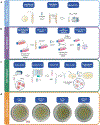Electro-antibacterial therapy (EAT) to enhance intracellular bacteria clearance in pancreatic cancer cells
- PMID: 38377890
- PMCID: PMC11648442
- DOI: 10.1016/j.bioelechem.2024.108669
Electro-antibacterial therapy (EAT) to enhance intracellular bacteria clearance in pancreatic cancer cells
Abstract
Intratumoral bacteria have been implicated in driving tumor progression, yet effective treatments to modulate the tumor microbiome remain limited. In this study, we investigate the use of electroporation in combination with metronidazole to enhance the clearance of intracellular Fusobacterium nucleatum within pancreatic cancer cells. We explore various parameters, including electric field strength, pulse width, and pulse number to assess the permeability of pancreatic cancer cells infected with F. nucleatum, compared to non-infected cells of the same type. We subsequently quantify the clearance of intracellular bacteria when these pulsing schemes are applied to a suspension of infected pancreatic cancer cells in the presence of metronidazole. Our results reveal distinct differences in cell permeability between infected and non-infected cells, identifying a unique biophysical marker for host cells infected with F. nucleatum. We demonstrate that the combinatorial use of electroporation and metronidazole significantly enhances the delivery of metronidazole into host cells, leading to more effective clearance of intracellular F. nucleatum compared to independent treatments; we term this novel approach Electro-Antibacterial Therapy (EAT). EAT holds promise as an innovative strategy for addressing intratumoral bacteria in pancreatic cancer, other malignancies, and potentially treatment-resistant infections, offering new avenues for therapeutic intervention.
Keywords: Antibiotic; Bacteria; Electroporation; Fusobacterium; Pulsed Electric Fields; Tumor Microbiome.
Copyright © 2024 Elsevier B.V. All rights reserved.
Conflict of interest statement
Declaration of competing interest The authors declare the following financial interests/personal relationships which may be considered as potential competing interests: The authors have a pending patent on the concept described in this article. Rafael V. Davalos has ownership interest for startup companies within the field of bioelectrics. In addition, Davalos also receives royalty income from technologies he has invented.
Figures



References
-
- Sung H, Ferlay J, Siegel RL, Laversanne M, Soerjomataram I, Jemal A, and Bray F, “Global Cancer Statistics 2020: GLOBOCAN Estimates of Incidence and Mortality Worldwide for 36 Cancers in 185 Countries,” CA: A Cancer Journal for Clinicians, vol. 71, pp. 209–249, 5 2021. - PubMed
-
- Hanahan D, “Hallmarks of Cancer: New Dimensions,” Cancer Discovery, vol. 12, pp. 31–46, 1 2022. - PubMed
-
- Casasanta MA, Yoo CC, Udayasuryan B, Sanders BE, Umaña A, Zhang Y, Peng H, Duncan AJ, Wang Y, Li L, Verbridge SS, and Slade DJ, “Fusobacterium nucleatum host-cell binding and invasion induces IL-8 and CXCL1 secretion that drives colorectal cancer cell migration,” Science Signaling, vol. 13, p. 9157, 7 2020. - PMC - PubMed
MeSH terms
Substances
Grants and funding
LinkOut - more resources
Full Text Sources
Medical

